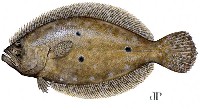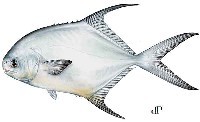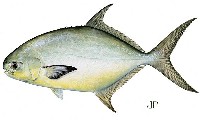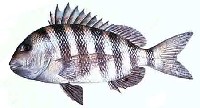|
|
The Fish
Contact me now while the Snook, Sea Trout, Tarpon and Redfish bite is on!!
and let me put you on the fish!
|
|

|
Barracuda - The speed and aggressiveness of a barracuda are amazing to watch, and hooked fish often jump from the water as they race past the boat. Averaging around 20 pounds and exceeding 40 pounds, the great barracuda can be caught all year on the Treasure Coast, but the best fishing is during the warm summer months from May through October.
We target barracuda with spinning and fly tackle, often live chumming the fish around offshore buoys or wrecks. The sharp teeth of the barracuda require the use of a wire leader, and the strikes are typically very visual and close to the boat.
While there is no size or bag limit on barracuda, we typically don't keep them for comsumption.
|
|

|
Blackfin Tuna - A schooling fish that's strong and aggressive, the blackfin tuna averages around 20 pounds, but fish up to 30 pounds are common along the Treasure Coast. Blackfin tuna can be caught all year, but the best action is in the spring and fall months. Typically caught on the edge of the Gulf Stream while targeting multiple gamefish, blackfin tuna will explode on live baits and peel off line.
They are excellent table fare, and during the summer months can be encountered on the edges of the bonito (little tunny) schools. In the fall, smaller blackfin and skipjack tuna move into the area in big schools, and there are days when anglers can catch double digit numbers of both species.
There are no size or bag limits on blackfin tuna, but as a rule, we only keep the larger ones or a couple of fish for the table.
|
|

|
Blacktip Shark - One of the most underrated species in the area, the Treasure Coast hosts a variety of shark species, but the ones we like to target are blacktip and spinner sharks, which average somewhere between 50 and 100 pounds. Spinner sharks jump out of the water and spin when hooked, and both species are extremely fast and aggressive.
For the most part, we target these species with fly tackle, but they can also be a lot of fun on spinning or plug tackle, and will strike topwater plugs with a vengeance. These sharks school in huge numbers off the beaches from February through May, and the large concentrations of sharks allow us to anchor and use chum to draw them near the boat. From there, they are incited to chase large flies and plugs using chumming techniques so that the shark is on the surface with its face out of the water striking at the offering. The fish are just as fun to watch as they are to catch.
There is a one shark per person or two sharks per vessel bag limit on sharks in Florida waters, but as a rule, we don't bring sharks into the boat.
|
|

|
Cobia - Cobia can be caught all year along the Treasure Coast, but we get two consistent runs: Valentine's day through mid-March, and June-July. The winter run produces the largest fish on average, but the summer run can yield fish over 80 pounds, and most of the summer fishing takes place along the beaches in less than 20 feet of water.
A great fighting fish that's also good to eat, cobia are a schooling fish that often can be found dogging stingrays, whale sharks and turtles, or simply swimming along on the surface. They eat everything from squid to shrimp, baitfish and even eels, which makes them easy to target with spinning, plug or fly tackle. My favorite way to target cobia is with fly tackle and large poppers, although chartreuse colored jigs or Bass Assassin 5-inch swimbaits are also deadly on these fish.
The average cobia is between 20-30 pounds, but fish over 50 pounds are common. There is a period during the summer months when cobia can be found along the beaches in great numbers, and the day is spent running from one school to the next, catching fish until the angler gets tired.
In Florida waters there is a one fish per angler bag limit and 33-inch to the fork in the tail minimum size limit on cobia.
|
|

|
Dolphin (Mahi) - A favorite for offshore anglers because of their table value, dolphin are a schooling fish that can be encountered year-round on the Treasure Coast. The Gulf Stream is anywhere from 10-12 miles east of shore, but dolphin can be caught as close as a couple miles from shore. For the most part, the best dolphin fishing takes place in water over 70 feet deep, which puts us six or seven miles off the coast. The fish typically hold close to weedlines.
Dolphin are a schooling fish, with the average fish around 10 pounds, but fish over 40 pounds fairly common. When one dolphin is hooked, the rest of the school often follows the hooked fish to the boat, allowing all the anglers on board to get in on the action.
We typically target dolphin with spinning or fly tackle, and they are a common catch when live chumming for little tunny and other gamefish with fly tackle. April and May produce the largest dolphin of the year, but the seas are typically rough during those months, so opportunity to run offshore is limited. As a rule, we fish dolphin on calm days, particularly during the summer and fall.
There is a 20 inch minimum size limit on dolphin measured to the fork in the tail, and a 10 fish per person bag limit.
|
|

|
Flounder - The tasty flounder can be targeted all year on the Treasure Coast, but August through November and April-May are the best months. The average flounder in this area is from one to three pounds, but fish over 12 pounds are fairly commonplace.
Flounder have both their eyes on the top of their head, which allows the fish to lie flat on the bottom, remaining motionless until its prey comes within striking distance. Most of the flounder we find in Florida waters are Southern flounder, which are left-facing flounder. Flounder are extremely aggressive, which makes them easy to target, and they often school in the same area.
They will eat shrimp and baitfish, with finfish like mullet and pilchards the top offerings, although they can also be targeted with small white curly-tailed jigs bounced along the sand or mud bottom. Flounder often hang out around bridge or dock pilings in shallow water, feeding on the schools of small baitfish also attracted to these structures.
In Florida waters there is a 12-inch minimum size limit and 10 fish bag limit on Flounder.
|
|

|
Jack Crevalle - One of the hardest fighting fish in the water, the yellow colored jack crevalle ranges in size from about a pound on up to 40 pounds or more. They are a schooling fish that will jump on almost any lure or bait offered, and leave town with authority when hooked. Fish over 20 pounds will put up a surprising fight that may last an hour or more depending on the tackle.
Most anglers think of jack crevalle as an incidental catch when targeting more glamorous gamefish, but here on the Treasure Coast, we regularly target these fish, particularly the larger specimens. On fly tackle a jumbo jack crevalle will explode a surface popper and test the fish fighting qualities of the angler. The largest jacks often travel in schools along the beaches from December through July, with 500 or more fish "finning" on the surface.
Jack crevalle are fast and explosive, exhibiting raw power when striking. It's not uncommon to have several jacks over 25 pounds fighting over a lure or fly, with the fish blowing giant holes in the water as they chase the offering. This is a very visual fishery that will have you coming back for more. Jack crevalle are not considered good table fare, so most of the fishing is catch and release.
|
|

|
Kingfish - Fast, powerful and super aggressive, the king mackerel is one of the most commonly targeted offshore gamefish on the Treasure Coast. Shaped like torpedoes with razor sharp teeth, the king mackerel (also known as kingfish), are a schooling fish, although the largest tend to be loners at times.
The average king mackerel on the Treasure coast is from 8 to 20 pounds, but fish over 40 pounds are common, and fish over 60 pounds have been caught. They are abundant year-round, but the best fishing takes place during the months of April and May, and again in August-December, when large schools migrate through the area.
Because they travel in schools, they respond well to live chumming, and become aggressive and competitive for their food to their point that they will readily eat flies. Live bait is deadly on kingfish, which often strike the rear of the bait, severing the tail to immobilize their quarry, before making a wide turn to return to eat the rest of the bait.
Considered good table fare when eaten the same day or smoked, there is a 2 fish per person daily bag limit on king mackerel with a 24 inch minimum size limit measured to the fork in the tail.
|
|

|
Ladyfish - Nicknamed "poor man's tarpon", the ladyfish is extremely aggressive, fast and acrobatic, three of the best qualities in inshore gamefish. These skinny fish average around a pound and rarely exceed three pounds, but put on a show for light tackle and fly anglers. They are a schooling fish found on the flats and around spoil islands.
Ladyfish like fast moving baits like the Nylure jig or the Catch 2000 MirrOlure. The greatest concentrations of ladyfish arrive in October and remain through May. For the most part, ladyfish are an incidental catch when targeting seatrout or pompano, but they sure are fun to catch.
If you eat a ladyfish, you will remember it for the rest of your life as the nastiest, most fishy dinner you've even eaten.
|
|

|
Little Tunny (Bonito) - Pound for pound one of the toughest, fastest, most dependable fish to target, the little tunny is often considered a nuisance by offshore anglers because they're not great table fare. But they fight. Hard.
Starting in early June, the little tunny migrate into the area, and can be caught in good number through September. July and August are the best months, and unlike fishing for this species in the Carolinas during the fall, our summer fishing takes place in flat calm seas.
Little tunny are a schooling fish and a species I like to target regularly with my fly anglers. They race through the chum line and will dump a nine weight fly reel or light spinning outfit when hooked. They strikes are spectacular, as the fish race through the chum line, eating the fly or bait at full speed then racing off.
The average little tunny is somewhere around 10-12 pounds, but fish over 15 pounds are commonplace. They’re not good table fare, but you can catch them until you say, "Uncle", which makes them a great target for fly anglers who don't have a lot of experience fighting powerful, fast fish.
|
|

|
Permit - One of the most coveted inshore gamefish in the world, the wily permit is usually targeted in the waters of the Florida Keys and Central America, but more anglers are learning about the incredible permit fishery off the Treasure Coast where some of the largest permit can be found.
Permit migrate through the area from late March through August, and average 15 to 25 pounds, while fish over 50 pounds can be captured. They are a schooling fish, so where you find one, there will be more, often hundreds more. For the most part, our permit fishing is done along the beaches or over shallow wrecks within a few miles of shore.
These hard fighting fish never give up, and will test your skills with spinning or fly tackle. The average summer permit is close to 30 pounds, and will produce a fight that may last well over 30 minutes, depending on the tackle.
Permit are crab eaters, although they will also take large live shrimp. But for the most part, we target these fish with live crabs or crab flies.
Although considered edible, we do not keep permit for consumption.
|
|

|
Pompano - The Florida pompano is one of the best eating fish found in inshore waters. They average a little over a pound and rarely get over five pounds, but fight like fish twice their size. A member of the jack family, pompano better resemble permit than jack crevalles for their table qualities as well as their fight. They are tough fish on light tackle and fly, and willing to eat everything from a live sandflea to a Nylure jig.
Pompano can be caught all year along the Treasure Coast, but the best fishing takes place from November through April when the schools migrate through the area after wintering in the Carolinas. They are a schooling fish that can on occasion be caught in impressive numbers, but for the most part produce enough action to fill out a day on the water and dinner for the evening.
There is an 11-inch minimum size limit on pompano, only one of which may be over 20 inches, and a six fish per angler daily bag limit.
|
|

|
Redfish - A schooling fish that fights well and eats crustaceans as well as baitfish, the redfish (red drum) is a bulldog that will slug it out around pilings or bury itself in the grass of the open flats. The average redfish in Treasure Coast waters is four to eight pounds, although we occasionally catch larger fish, particularly in the ocean.
Redfish love gold spoons, topwater plugs and soft plastics, especially those with the colors gold, pink or orange. They readily eat shrimp and live pilchards, two of the most popular baits to fish on the flats.
In Florida, anglers are allowed to keep one redfish daily, with a slot size between 18 and 27 inches. They can be caught all year along the Treasure Coast, with January through April one of the top periods. They also school up on the flats in October.
|
|

|
Sailfish - Sailfish are abundant in our waters all year long, which is why the Treasure Coast carries the nickname "Sailfish Capital of the World." Known for their aggressiveness and the visual method of striking a baitfish with their bill to kill it and then turning back to eat their quarry, sailfish are acrobatic gamefish to the extreme.
From December through March, sailfish migrate through the Treasure Coast waters in huge numbers, often producing double digit days of catch and release fishing. When the baitfish are thick offshore, sailfish often work in unison to circle the baitfish school and tighten their ranks (called "balling the bait") then feeding from the tightly packed school. This visual feeding activity is just as beautiful to watch as it is effective to fish.
Unfortunately, the best sailfish actions takes place in rough seas, although we do catch a good number of them on calm days when live chumming for offshore gamefish. During the summer months, we typically raise at least one sailfish every day when fly fishing or live chumming.
Sailfish are open to harvest, with a 63-inc lower jaw to the fork in the tail measurement and a one fish bag limit, but we don't keep sailfish.
|
|

|
Seatrout - The most popular inshore gamefish in Florida waters, the spotted seatrout is known for its aggressiveness and willingness to strike a lure or bait. Smaller seatrout (under five pounds) travel in schools, while the larger fish are often loners or travel in groups of two to six fish.
Any seatrout over seven pounds is considered a trophy, and the waters of the Treasure Coast, and particularly the Indian River Lagoon are where the largest fish in the world are taken (the world record 17-pound, 7-ounces was caught in nearby Fort Pierce). Fish over 10 pounds are regularly caught.
Seatrout are a year-round targeted species that feeds on crustaceans and baitfish. They are suckers for a soft plastic jerkbait like the Bass Assassin Texas Roach colored Texas Shad with a 1/8-ounce leadhead. Topwater plugs also work well on these fish, and a live shrimp is like candy to them.
The largest seatrout of the year are taken from April through August, although the winter months also produce some trophy fish. School fish can be caught all year, with the best action in February and March.
On the Treasure Coast there is a four fish bag limit on spotted seatrout, with a slot limit of 15-20 inches, only one fish may exceed the slot limit. For the most part, we release all the trophies to ensure the genetics of the larger, faster growing fish, remains in the estuary. Spotted seatrout are closed to harvest during the months of November and December, but are still fun to catch and release.
|
|

|
Sheepshead - During the months of January and February, sheepshead school up on the shallow flats to spawn. These fish range in size from one to 10 pounds, and are good table fare. They're a great fish to target with young kids, and also a challenge to catch on fly. This is sight fishing to schools of fish sitting along channel edges on the flats.
Sheepshead are crustacean eaters that love a live shrimp or sandflea. There is a 12 inch minimum size limit and 15 fish per angler bag limit on sheepshead.
|
|

|
Snapper - A popular target for young anglers, the hard-fighting snapper averages around a pound and is excellent table fare. The majorityof snapper we target are mangrove (grey) and lane snapper, although we also catch mutton snapper and cubera snapper.
These fish are very structure oriented, and like to hang out around submerged trees, docks or rocks where they are safe from predators. They are a schooling fish, extremely aggressive and fun to catch on light tackle.
Snapper can be caught year round, but the best action is from June through November, with the largest fish moving from the offshore reefs to the inlet during the summer months to spawn. Snapper will eat live shrimp and baitfish, with small live pilchards one of their favorite foods.
They are excellent table fare, producing a white flaky meat. In Florida waters there is a 10 inch minimum size limit and five fish bag limit on mangrove snapper.
|
|

|
Snook - One of the most sought after inshore gamefish in Florida waters, the snook is an aggressive fish that puts up a strong fight. Snook are great to eat, which makes a successful day chasing them even more rewarding. These fish eat crustaceans as well as baitfish, so we target them with a wide variety of live baits, lures and flies.
Snook like to hang out around structure like docks, bridge pilings and seawalls, where they ambush their prey as it moves by with the tide. Snook also feed in the open flats, where topwater lures like the Rapala Skitterwalk, Heddon Zara Spook and MirrOlure Top Dog are the preferred offerings. Soft plastics like the Bass Assassin Sea Shad in Drunk Monkey or Space Guppy colors.
Although snook can be caught all year long on the Treasure Coast, the months from April through November are best. There are four species of snook caught here on the Treasure Coast (common snook, fat snook, tarpon snook and swordspine snook), and only the common snook regularly reaches the legal slot size for harvest.
On the east coast of Florida, snook have a slot size of 28 to 32 inches and a 1 fish per angler bag limit. Open season for keeping snook is February 1 through May 31, and September 1 through December 14.
|
|

|
Spanish Mackerel - A popular gamefish from November through April, the slashing strike of a Spanish mackerel is hard to miss. Considered good table fare, these fish average one to six pounds, and can be caught up to eight pounds. Most of the fishing is done along the beaches and around the inlets, although Spanish mackerel will travel into the rivers at times.
Spanish mackerel migrate to the Treasure Coast in the fall, wintering here in immense numbers. These fish are a blast to catch on light spinning or fly tackle, and because they are a schooling fish, it's not uncommon to catch all you care to tangle with. Spanish mackerel will eat shrimp or baitfish, and are suckers for fast-moving jigs. We like to chum them up with live pilchards, then throw flies or swimming plugs like the Yo-Zuri Crystal Minnow at them. This produces the larger fish.
Spanish mackerel have a 12 inch minimum size limit and 15 fish bag limit, but I suggest you keep only what you plan to eat right away, as the fish don't freeze well. They are excellent smoked, and make great fish spreads.
|
|

|
Tarpon - A favorite for sportsmen, the tarpon is an acrobatic gamefish that often exceeds 100 pounds in weight. Tarpon anglers chase these species all over the world, and the Treasure Coast is one of the best places in Florida to target this species. Considered garbage cans because they eat just about anything from chunks of dead ladyfish to live mullet and crabs, tarpon in this area range in size from 10 to 150 pounds.
You can target tarpon all year on the Treasure Coast, but the fish are less aggressive during cold weather. The peak months are from April through November, with a major migration taking place along the coast from late May through early July.
Tarpon love topwater plugs like the Heddon Zara Spook, Rapala SkitterWalk and MirrOlure Top Dog, particularly during the fall mullet run that takes place in September and October. June is the top month to target these fish with fly, although they can be caught on fly throughout the summer.
Tarpon are not considered good eating and are a catch and release fish only.
|
|

|
Wahoo - Fast, aggressive and flat out mean, the wahoo appears out of nowhere, feeds and moves on. When hooked they are among the fastest fish in the ocean, and the larger specimens will dump all the line off the reel on the first long run. The average wahoo we encounter on the Treasure Coast is around 20 pounds, but fish over 50 pounds are fairly common.
Not as common as dolphin, wahoo are caught on the edge of the Gulf Stream, usually around structure or floating lines of sargassum weed. The small fish holding under the weed make up a large portion of the wahoo's diet. During the summer months, wahoo dog the little tunny schools, often feeding from their ranks. It's common to hook a little tunny, and have a wahoo eat it right at the side of the boat.
Wahoo are difficult to target because of their range and movements, and most of the wahoo we land are part of incidental catches when targeting dolphin and little tunny. As a rule, any time we are live chumming offshore we are targeting a variety of gamefish, wahoo included.
There are no size or bag limits on wahoo.
|
|






















